文献译文-新型的基于web的在线考试系统
c#在线考试系统参考文献(精选100个)

在线考试系统是基于C#编程技术把学科、试题、电脑改卷、结果查询的部分管理工作集成到一个同一的平台,各管理人员能够及时、准确的了解学生学习生活情况。
同时,也可以方便老师针对学生的不同情况进行分层次帮助引导。
下面是整理好的关于c#在线考试系统参考文献100个,供大家参考。
c#在线考试系统参考文献一:[1]邓英伟,袁晓红,张小琳,谭艳,彭伟. 智能在线考试系统研究[J]. 海峡科技与产业,2017(10):67-68+74.[2]魏国利,张成刚. 基于框架的在线考试管理系统设计与实现[J]. 信息与电脑(理论版),2017(23):121-122+125.[3]杨晓吟. 多样化题型在线考试系统的实现[J]. 数字通信世界,2017(11):214+217.[4]蒋玉芳. 基于的在线考试系统的设计与实现[J]. 科技广场,2017(08):35-38.[5]颜石,杨琨,刘杰. 预报业务在线学习考试系统设计[J]. 科技风,2018(06):6+8.[6]刘晓婷,刘丰恕,朱斌. 基于的机械CAD/CAM课程在线考试系统的设计与实现[J]. 软件导刊(教育技术),2018,17(01):86-88.[7]张东圆,袁同山. 基于Drupal的在线考试系统的研究与应用[J]. 信息系统工程,2018(01):92+94.[8]马生骏. 基于AJAX技术在线远程考试系统的设计与实现[J]. 甘肃科技纵横,2018,47(01):1-3.[9]林志灿. Struts与Hibernate框架下在线考试系统的设计与实现[J]. 信息技术与信息化,2018(01):79-83.[10]伍四军. 一种基于WEB的在线考试系统设计[J]. 科技广场,2017(11):47-50.[11]刘冬,冉崇善. 基于C/S模式的计算机应用在线考试系统分析[J]. 计算机产品与流通,2017(08):31.[12]黄春. 基于JSP的在线考试系统的开发与设计[J]. 信息通信,2018(02):163-164.[13]金圣道. 在线考试及试卷分析系统的设计与实现[J]. 电子技术与软件工程,2018(07):170-171.[14]马万强. 计算机在线考试系统的设计与实现[J]. 信息与电脑(理论版),2018(05):74-75+78.[15]金誉华,周蕾. 基于可变比例的模块化试题生成的在线考试系统的设计与实现[J]. 安徽电子信息职业技术学院学报,2018,17(02):14-17.[16]郭子文,刘平. 基于MVC模式的在线考试系统设计与实现[J]. 电脑知识与技术,2018,14(05):71-72.[17]王保银,雷新华. 中职JAVA在线考试系统的研究[J]. 电脑知识与技术,2018,14(07):75-77.[18]吴光成. 基于.NET的在线考试系统的设计与实现[J]. 教育教学论坛,2018(22):94-95.[19]肖宏飞,晋太洋. 职业技能鉴定在线模拟考试系统设计与实现[J]. 芜湖职业技术学院学报,2018,20(01):12-17.[20]崔清宇. 基于J2EE架构的MVC模式在线考试系统[J]. 电脑编程技巧与维护,2018(05):19-21+49.[21]左匡天,韩露男. 在线练习及考试系统的设计与实现[J]. 电脑知识与技术,2018,14(11):112-114.[22]路晓亚. 基于在线考试系统的异构数据源集成技术研究[J]. 福建电脑,2018,34(06):84-85+139.[23]宋超,吴明. 数据挖掘在中职在线考试系统中的应用[J]. 科学大众(科学教育),2018(08):98.[24]张衡. 云在线考试系统容量规划的设计与实现[J]. 江苏科技信息,2018,35(17):50-54.[25]沙飞,张楠,刘文艳,王珂,杨淼,翟阳阳,谢艳. 医学院校在线考试系统的设计与实现研究[J]. 中国医学装备,2018,15(07):130-133.c#在线考试系统参考文献二:[26]张素珍,王月春,田卫辉,单振芳,白增山. 基于在线考试系统精准教学模式设计与实现[J]. 电脑知识与技术,2018,14(18):114-115.[27]吕云翔,刘艺博,刘瀚诚. 浅析分布式在线考试系统的实现[J]. 工业和信息化教育,2018(03):71-77.[28]王克垒,宋超. B/S架构下中职在线考试系统的设计与实现[J]. 信息与电脑(理论版),2018(13):86-87.[29]徐亮,吴付国,唐心敏. 基于C/S模式下的党员在线考试系统设计与实现[J]. 电脑编程技巧与维护,2018(07):34-35+59.[30]涂振宇. 基于JavaEE的在线考试系统的研究与实现[J]. 电脑知识与技术,2018,14(16):74-76.[31]郭霞. 使用开发基于B/S模式的在线考试系统[J]. 电脑知识与技术,2018,14(16):92-94.[32]李春梅,杨瑶,达娜·木拉提. 护理学专业在线考试系统的应用初探[J]. 实用临床护理学电子杂志,2018,3(18):194-195.[33]王卿蕾. 在线考试系统的分析与设计[J]. 信息与电脑(理论版),2018(15):105-106.[34]石亚妮. 基于B/S构架的远程教育学生在线考试系统设计[J]. 自动化技术与应用,2018,37(07):48-51+54.[35]肖慧. 基于网络教学平台的在线考试系统的开发[J]. 科技创新导报,2018,15(11):206-207.[36]杜博,吴敏宁. 基于Java的在线考试系统的设计与实现[J]. 微型电脑应用,2018,34(09):90-93.[37]刘海燕,李显风. 关于气象培训在线考试系统设计与开发的研究[J]. 电脑迷,2018(10):170.[38]刘先花. PHP技术应用于在线考试系统的设计[J]. 电脑编程技巧与维护,2018(09):89-90+96.[39]赵秀芳,古瑶. 混合学习模式与在线考试系统在儿科护士在职培训中的应用效果研究[J]. 卫生职业教育,2018,36(19):143-145.[40]金强,王亮,方春华. 计算机信息技术课程在线考试系统的设计与实现[J]. 软件工程,2018,21(11):59-62+58.[41]贾寒霜,黄军峰. 浅析在线考试系统的发展现状与趋势研究[J]. 电脑迷,2018(11):271.[42]席洁,杭欣静. 基于UML与粒子群算法的在线智能考试系统设计[J]. 自动化与仪器仪表,2018(09):121-124+130.[43]熊宗杨,薛学斌,王欣,唐万梅. 基于过程化考核的在线考试系统的研究与实现[J].重庆师范大学学报(自然科学版),2018,35(06):75-81.[44]胡木林. 基于遗传算法的在线考试系统组卷设计[J]. 中国教育技术装备,2018(12):23-27.[45]王卿蕾. 物理教学中在线考试系统的应用与成绩分析[J]. 中学物理教学参考,2018,47(20):10-11.[46]黄浩. 在线考试系统的设计与实现[J]. 淮北职业技术学院学报,2018,17(06):113-114.[47]李传秀,张学辉,田红磊. 程序设计在线考试题目生成系统研发[J]. 教育教学论坛,2018(51):153-154.[48]李宏坤,郑光勇,谢舞,彭承辉. 计算机专业课程在线考试系统的研究与设计[J]. 教育现代化,2018,5(44):203-207+211.[49]陈磊萍. 计算机应用在线考试系统设计与实现[J]. 计算机产品与流通,2018(09):86.[50]邹磊,汪博韬,谢高峰,蒋卫祥. 基于UML的通用在线考试系统的分析与设计[J]. 计算机产品与流通,2018(09):87.c#在线考试系统参考文献三:[51]封震震. 基于WCF技术框架的在线考试系统设计[J]. 电脑知识与技术,2018,14(28):56-57.[52]钟锐,李洁. 基于PCA特征的在线考试系统人脸身份验证[J]. 赣南师范大学学报,2018,39(06):29-32.[53]刘鹏飞,陈静超,田颖,孙颖,潘亮. 气象业务在线考试系统的本地化应用[J]. 现代农业,2018(11):107-108.[54]白永祥,原渊. 基于C#的在线考试系统设计与实现[J]. 电脑知识与技术,2016,12(27):54-56.[55]徐彩云. 具有自适应特征的在线考试系统的研究与应用[J]. 计算机时代,2017(01):30-33.[56]李晏超. 考试在线系统基于Web数据库的分析[J]. 通讯世界,2017(03):246-247.[57]龙万顺,姜学军. 基于Web角度下的在线考试系统研究[J]. 黑龙江科技信息,2017(01):178.[58]饶辉科. 基于J2EE+SQLServer在线考试系统设计与实现[J]. 福建电脑,2017,33(02):115-116+65.[59]谭红春,金力,高洁. 通用在线考试系统的开发与设计[J]. 齐鲁工业大学学报(自然科学版),2016,30(05):51-54.[60]高欣,张建莉,刘环,李建忠,李明. 移动终端在线考试系统的设计与实现[J]. 软件工程,2017,20(02):34-36+33.[61]杜月云,邢文凯. 集成异构数据源的在线考试系统研究[J]. 软件工程,2017,20(02):47-49.[62]周崟. 在线考试系统中用户模块的设计与实现[J]. 电子测试,2017(04):57-58.[63]郑辉,阎丽娟,罗豫,杨晓朋. 基于C#的在线考试系统设计与实现[J]. 电脑编程技巧与维护,2017(06):14-15+18.[64]赵艳茹. 在线考试系统设计[J]. 电脑编程技巧与维护,2017(08):13-14+22.[65]刘继红,梁雪剑. 职业技能鉴定在线考试系统设计与实现[J]. 科技资讯,2017,15(11):204-206.[66]王红梅. 基于C/S模式的计算机应用在线考试系统研究[J]. 西安文理学院学报(自然科学版),2017,20(03):73-77.[67]谢永浩,高嵩峰. 基于Android系统下的在线校园考试系统[J]. 科技与创新,2017(09):121-122.[68]钱晓贤,宋超. 基于B/S架构的在线考试系统在高职中的应用[J]. 电子制作,2017(10):99-100.[69]肖宏飞. 基于数字校园平台的职业技能鉴定在线模拟考试系统设计[J]. 韶关学院学报,2017,38(03):29-33.[70]饶辉科,苏伟平. 利用缓存预取技术优化在线考试系统[J]. 电脑知识与技术,2017,13(07):81-82.[71]姚娟. 校园信息化在线学习考试系统的建设——武汉铁路职业技术学院为例[J]. 电脑迷,2017(01):112+114.[72]胡跃清. 基于J2EE的在线考试系统构建探讨[J]. 现代商贸工业,2017(07):155-156.[73]朱佳轩,鄢雪梅. 基于Php-Web技术的在线考试系统设计[J]. 电子设计工程,2017,25(08):127-130.[74]王榕. 高职院校毕业总补考在线考试系统的设计[J]. 科技风,2017(06):74.[75]姚楚楚,陈宁. 侧脸识别在在线考试系统中的应用[J]. 西安工程大学学报,2017,31(02):238-243.c#在线考试系统参考文献四:[76]宋雪亚,王传安. 基于JSP的在线考试系统设计与实现[J]. 湖南工程学院学报(自然科学版),2017,27(02):33-38.[77]朱淑威. 在线考试视频监控系统研究与实践——以广东职业技术学院为例[J]. 电脑与电信,2017(05):41-42+46.[78]吴庆祥,李盛兰. 在线考试模块的设计与实现——基于Authorware的通用型考试系统[J]. 电脑与电信,2017(05):64-66.[79]马杰. 基于PHP的在线考试系统[J]. 河南科技,2017(09):49-50.[80]宋世俊. 基于.NET的计算机基础课程在线考试系统设计与实现[J]. 巢湖学院学报,2017,19(03):50-54+66.[81]周志锋,童凌,王浩茂,李海燕. 基于自动组卷与判卷的在线考试系统设计[J]. 软件导刊,2017,16(06):66-69.[82]崔兰超,李双双,马选宝. 基于Web的在线考试系统设计与实现[J]. 电脑编程技巧与维护,2017(14):23-25.[83]李娜,陶卫平. 基于Android的高校在线考试系统APP设计与开发[J]. 大众科技,2017,19(06):13-15+32.[84]杨威,张莹鑫,薛二虎. 智能在线考试系统的设计与实现[J]. 长春师范大学学报,2017,36(04):26-30.[85]胡跃清. “互联网+”背景下高校在线考试系统的研究[J]. 知识经济,2017(16):141-142.[86]王文凡,史丽丽. 基于的在线考试系统的设计[J]. 科技经济市场,2017(07):1-2.[87]李希. 基于B/S的在线考试系统设计[J]. 电脑迷,2017(10):45-46.[88]施晓晗. 基于微信公众平台的在线考试系统的设计与实现[J]. 苏州市职业大学学报,2017,28(03):29-33.[89]陈松楠,侯丽萍,朱艳平. 基于MySQL的在线考试系统数据库设计[J]. 信息通信,2017(08):151-153.[90]谭敏,范强,童宇. 在线考试系统的研究与设计[J]. 信息通信,2017(09):114-115.[91]裴霞,黄超,马怀志,刘梦琳. 基于MOOC-SPOC的在线考试系统模型设计研究[J]. 福建电脑,2017,33(08):35+37.[92]谭祥国. 理论知识在线考试系统的开发与研究[J]. 科学咨询(科技·管理),2017(09):53-54.[93]王樱,李锡辉,赵莉. 基于SSM框架的高校在线考试系统研究[J]. 电脑编程技巧与维护,2017(20):32-34.[94]刘超. 基于PHP的在线考试系统的设计与实现[J]. 电子技术与软件工程,2017(20):167.[95]朱二莉. 基于云计算的在线考试系统研究[J]. 电脑知识与技术,2017,13(28):75-76.[96]杨晓吟. 在线考试系统防止作弊机制[J]. 电子技术与软件工程,2017(22):160-161.[97]周胜,汤小燕. 浅谈基于WEB的在线考试系统[J]. 电脑知识与技术,2017,13(27):107+109.[98]叶溪溪,吴观茂. 在线考试系统分析与设计[J]. 电脑知识与技术,2016,12(03):104-106.[99]张锋. 基于C#的在线考试系统设计与实现[J]. 电脑知识与技术,2016,12(10):109-110.[100]刘思婷,顾乃杰,林传文. 在线考试系统中试题上传方法的优化[J]. 计算机工程与应用,2016,52(21):241-246.。
基于Web 的在线考试系统设计与实现

基于Web 的在线考试系统设计与实现作者:王建来源:《软件导刊》2014年第01期摘要:随着网络技术的发展,基于Web 的在线考试系统也日渐成熟和完善,在线考试己经成为未来考试的必然趋势。
对基于Web 的在线考试系统进行了介绍,并对基于Web 的在线考试系统开发过程进行了描述,对考试系统提出了一些优化方案。
关键词:Web ;在线考试;系统设计;系统优化中图分类号:TP319 文献标识码:A 文章编号文章编号:16727800(2014)001007002作者简介作者简介:王建(1980-),女,西北师范大学硕士研究生,研究方向为现代远程教育。
0 引言网络的普及和各种网络技术的发展,给人们的生活和工作带来了诸多便利。
考试,作为教育工作的一项重要内容,其也在经历网络化进程。
降低考试成本,解决繁重的考务工作是网络考试系统的优势。
由于试卷本身可以根据题库中的内容即时生成,并可自动阅卷和判定成绩,最后把成绩送到数据库中进行统计和汇总,所以网络考试系统使得教师不用再如以往那样,需要做充分的考前内容整理,同时也免去了教师考后的阅卷统计分析工作,真正实现了无纸化考试,工作效率较以往也得到了很大提升。
1 系统介绍基于Web 的在线考试系统实现在线出卷与考试等相关功能,是以Web 服务器为基础,采用HTML、ASP、Dreamweaver CS4、VBScript、Java编程语言等工具来访问Web 页面。
此系统主要应用为对试卷进行录入查询修改等功能以及参加在线考试的ASP应用程序,其特点为灵活性和方便性。
在线考试系统具有以下几个特点:①管理员可以向题库添加、修改和查询试题(卷),并基于此进行分类综合汇总,建立相应的数据库以及自动新增科目;②管理员可以对试卷的难易程度和形式以及各个题目的分数进行规划,从现有试题库中抽取各类试题构成需要的试卷;③考生在浏览器输入正确的信息后,系统会自动对身份进行有效与否验证,如果通过,考生会被规定在要求的时间内答题,系统在规定时间到后自动提交试卷,并且答案分数等记录会被数据库收录,方便以后审核和查阅;④电脑系统根据难度系数高低,随机抽取试题库中的试题进行各种形式和不同内容的组卷,这种形式的试卷称为实时互动试卷。
在线考试系统文献综述

中文摘要:随着网络技术的日益成熟,网络已经深入到生活的每一个角落,包括教育、购物、咨询、办公等等许多领域.在网络迅速发展的今天,网页技术的应用也越来越广泛.网页技术的应用对于教育行业来说优势更加的明显。
教育行业可以通过网络进行学生和教职工的管理、组织学生在线考试、在网站上发布学校相关信息等活动。
这样不仅能增加学校管理的透明度,还提高了学校的管理水平。
在线考试还能充分的利用学校的现有资源,大大减轻教师的工作量,把老师从出卷、阅卷等一些繁重中做中解脱出来。
本文重点论述了由于网络的存在扩大了学校的服务范围,为学校的管理提供了更多的条件。
对此做出了详细的调查,可行性研究和分析。
系统采用了B/S结构,在网络上建立学校自己的教育网站。
系统开发经历了系统分析、系统设计和系统实施三个阶段.从设计方案的提出,经过详细的调查,分析了方案的可行性和必要性,通过详细的系统设计,力图提高系统的集成性和快捷性;并在系统实施阶段收集了大量的实验数据,以便测试阶段系统的准确性和稳定性。
系统整体是基于浏览器/服务器,前台应用JSP技术,后台采用SQL Server2000作为数据库与前台连接。
关键词:网络教育在线考试B/S结构JSP技术AbstractWith the increasingly sophisticated network technologies,the network had penetrated every corner of life,including education, shopping, advice,office and so many fields. Today,therapid development of the network,the application of web technology more and more widely.Web technology advantage for the education industry is more evident. Education sector through a network of students and faculty management, student organizations,online examinations, in the website information and other school activities。
基于Web技术的在线模拟考试系统设计与实现案例

基于Web技术的在线模拟考试系统设计与实现案例随着社会的快速发展,人们对教育的要求也越来越高。
特别是在幼儿教育阶段,家长和教师都希望孩子们能够提前掌握更多的知识和技能。
然而,传统的考试方式往往无法满足这种需求,因此,基于Web技术的在线模拟考试系统应运而生。
一、系统需求分析1.功能需求(1)用户注册与登录:用户可以通过注册账号的方式登录系统,以便于管理和查询考试记录。
(2)考试题目管理:管理员可以在系统中发布、修改和删除考试题目。
(3)考试模拟:用户可以根据自己的需求选择不同的考试科目进行模拟考试。
(4)考试结果展示:用户完成考试后,系统可以自动评分并展示考试结果。
2.性能需求(1)系统响应速度:系统需要能够在短时间内完成用户的登录、考试、评分等操作,以提高用户体验。
(2)数据安全性:系统需要保证用户数据和考试数据的安全性,防止数据泄露或被恶意攻击。
(3)系统稳定性:系统需要具备较强的抗压能力,能够应对高并发、大数据量的场景。
二、系统设计1.技术选型(1)前端:HTML、CSS、JavaScript(2)后端:Java、PHP、Python等(3)数据库:MySQL、Oracle等2.系统架构设计(1)B/S架构:采用浏览器/服务器架构,方便用户通过Web端进行访问和操作。
(2)三层架构:将系统分为表示层、业务层和数据层,有利于代码分离和模块化。
3.模块划分(1)用户模块:包括用户注册、登录、修改资料等功能。
(2)题目管理模块:包括题目发布、修改、删除等功能。
(3)考试模拟模块:用户可以选择题目进行模拟考试。
(4)考试评分模块:系统自动对用户提交的答案进行评分。
(5)考试记录模块:用户可以查看自己的考试记录和成绩。
三、系统实现1.前端实现(1)HTML页面:使用HTML标签搭建考试系统的页面结构。
(2)CSS样式:通过CSS样式美化页面,提高用户体验。
(3)JavaScript脚本:使用JavaScript实现页面的动态交互功能。
论文在线考试系统的技术路线(可编辑)

摘要随着社会的进步和商品经济的不断发展,社会对劳动者和技术人员的知识和能力水平的要求越来越高。
考试作为衡量人的能力的重要手段,在现代生活中的地位进一步提高,并深入到社会的各个方面。
计算机应用迅猛发展,网络应用不断扩大,如远程教育和虚拟大学的出现等,使得基于Web的在线考试系统成为现实。
在线考试系统是集合现代考试理论、方法和现代信息技术手段的智能化网上考试系统,为学生个性化学习提供灵活、方便、科学、公平的个别化考试服务,学生可以随时随地进行课程结业考试,它可以节约考试成本,提高考试工作的效率。
本论文叙述了在线考试系统开发过程中的主要技术,包括基于 B/S的服务模式、ASP语言和Access 2003数据库管理系统等,重点介绍了在线考试系统的开发过程:包括系统分析、系统调查、数据流程分析、功能设计、数据库设计、系统物理配置方案、系统实现、系统调试和测试。
关键词:在线考试 ASP Access数据库 Web 自动评分目录摘要I目录 I第一章序言 11选题背景 12在线考试系统的技术路线 1 1ASP基本对象简介12SQL Server语句简介23SQL语句简介 2第二章系统设计相关原理 3 1ASP技术 31 ASP的特点 32 ASP处理流程32Javascript 33Access 2003数据库 44SQL语句 45B/S模式及其优势4第三章系统设计 51系统需求分析51考生使用在线考试系统流程5 2系统特点 53系统目标 52系统功能结构图 51系统总体结构设计 52系统模块设计63前台功能模块64后台功能模块63数据库的分析与设计61表设计72创建表间关系7第四章系统实现81前台功能的实现81登录页面82注册页面82后台功能的实现81后台登录页面82后台管理首页8致谢10参考文献11第一章序言(1)选题背景现今,不管是国内还是国外的各大机构,都不断的推出了一系列大型的认证考试,如微软的MCSE、Cisco的CCNA以及我们国家的自学考试和各省市的各种考试等,这些考试都在朝着网络化的方向发展,只有这样才符合大规模考试省时省力以及公正公开的要求。
基于Web的考试系统设计及其技术实现

图 1 “ 线 考 试 系统 ” 据 库 设 计 图 在 数
维普资讯
湖北 教育学院学报
是—个质 的提高。() 2 系统存储过程概述。以下是整个系统使用 2 组卷策 略的设计 组 卷过程不 能是 简单 地 随机 抽 取试题 , 应该 使 知识 点 的 覆盖范 围尽 可能地全 面 , 难度级别合 理 , 给管理 员更 大的管 理 功能, 充分体现组卷的科学性与合理性 。 2 1 设置组卷参数 .
基 于 Wl e b的 考 政 系 统 设 计 及 其 技 术 实 现
杨 莉 黄 帅2
( 湖北教育学院,武汉 400 ; 武汉语言文化职业学院, 1 325 2 武汉 400 ) 3 5 2
摘要 : 于 W b 基 e 的考试 系统具有高效率和 易维护性 , 利用.E 技术设计和实现 了 NT 在线考试 系 统。 论述 了系 统功能设计和 系 统实现技术。重点分析 了 试题库 的 计, 了组卷方案。真正实现了无纸化的在线考试 , 设 讨论 具有较强的应用价值。
员的信息。对数据库 中的学生 和教师 信息 , 系统 管 理员 具有
无 限制的权 限 , 以增 加 、 除 改。可 以对 学 校进 行 管 可 删 戈修 理 , 以添加、 除或更 改学 校信息 。可 以对 院系进 行管 理 , 可 删 可以添加 、 除或更 改一个 学校 下的所 有 院系。可 以对 生 : 管理员允许注册条件下考生可 以进行在线注册。 以 可 修改注册的资料( 如修改密码 、 邮箱等信息) 。参加过考试的考生 可以方便地进行各科 目的分数查询。已注册 的考生可以进行 在
线考试 , 交卷后可 以马上得到考试成绩。
收稿 日期 : O — 5— 0 2 6 0 1 O
向素质教育。因而对试题库的建设也有必要加 以研究。
基于WEB的JAVA在线考试系统的设计与实现
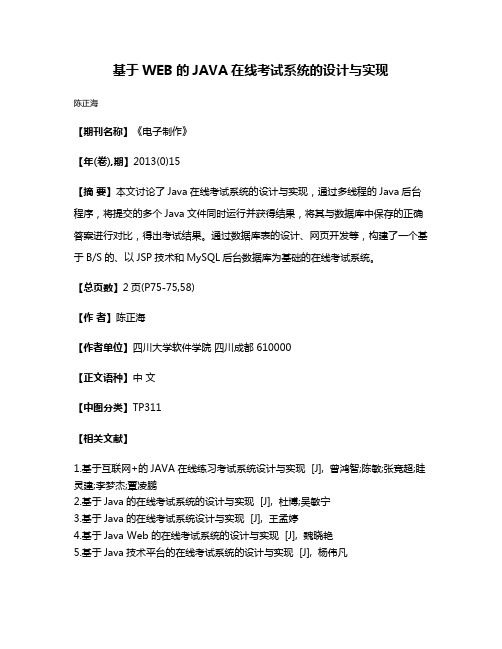
基于WEB的JAVA在线考试系统的设计与实现
陈正海
【期刊名称】《电子制作》
【年(卷),期】2013(0)15
【摘要】本文讨论了Java在线考试系统的设计与实现,通过多线程的Java后台程序,将提交的多个Java文件同时运行并获得结果,将其与数据库中保存的正确答案进行对比,得出考试结果。
通过数据库表的设计、网页开发等,构建了一个基于B/S的、以JSP技术和MySQL后台数据库为基础的在线考试系统。
【总页数】2页(P75-75,58)
【作者】陈正海
【作者单位】四川大学软件学院四川成都 610000
【正文语种】中文
【中图分类】TP311
【相关文献】
1.基于互联网+的JAVA在线练习考试系统设计与实现 [J], 曾鸿智;陈敏;张竞超;眭灵建;李梦杰;覃凌鹏
2.基于Java的在线考试系统的设计与实现 [J], 杜博;吴敏宁
3.基于Java的在线考试系统设计与实现 [J], 王孟婷
4.基于Java Web的在线考试系统的设计与实现 [J], 魏晓艳
5.基于Java技术平台的在线考试系统的设计与实现 [J], 杨伟凡
因版权原因,仅展示原文概要,查看原文内容请购买。
基于WEB技术的网上考试系统设计与应用
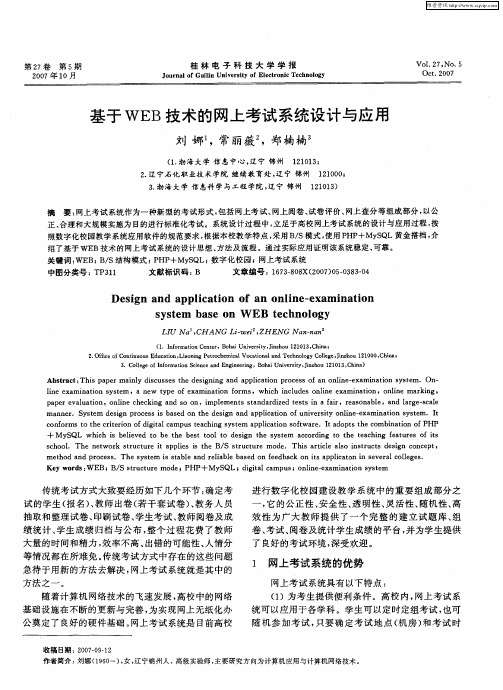
照数字化校园教学系统应用软件的规范要求 , 根据本 校教 学特点 , 用 B S模式 , 采 / 使用 P +My QL黄金搭档 , HP s 介 绍了基于 WE B技术 的网上考试系统 的设计 思想 、 方法及流程 。通过 实际应用证 明该 系统稳 定、 可靠 。
关 键 词 : B; / WE B S结构 模 式 ; HP P +My QL; 字 化 校 园 ;网 上 考 试 系 统 S 数
+ M y QL whc s b l v d t e t e b s o lt e in t e s se ac r ig t h e c ig fau e fi S ih i ei e o b h e tto o d sg h y tm co dn o t e ta hn e t rs o t e s
Oc . 0 7 t2 0
20 年 1 07 0月
基 于 WE B技 术 的 网 上考 试 系 统 设 计 与 应 用
刘 娜 ,常 丽薇 ,郑 楠 楠。
( . 海 大 学 信 息 中心 , 宁 锦 州 1 1 1 ; 1渤 辽 20 3 2 辽 宁 石 化 职 业技 术 学院 继 续 教 育 处 , 宁 锦 州 1 1 0 ; . 辽 2 00
Ab t a t Th s p p r ma n y d s u s s t e d sg n n p l a in p o e s o n o l e e a i a i n s s e sr c : i a e i l ic s e h e ini g a d a p i t r c s fa n i — x m n t y t m.On c o n o — l e e a n t n s s e ,a n w y e o x mi a i n f r s i x mi a i y t m n o e t p f e a n t o m ,wh c n l d s o l e e a n to o ih i cu e n i x mi a in,o l e ma k n n n i r i g, n p p r e a u t n,o l e c e k n n O o a e v lai o n i h c i g a d S n,i l me t t n a d z d t s s i ar e s n b e,a d l r e s ae n mp e n s s a d r ie e t n a f i ,r a o a l n a g — c l ma n r y t m e in p o e s i a e n t e d s g n p l a in o n v r i n i e e a n t n s s e n e .S s e d s g r c s sb s d o h e in a d a p i to fu ie s t o l — x mi a i y t m.I c y n o t c n o ms t h rt r n o i ia a u e c i g s s e a p ia i n s fwa e t d p s t e c mb n t n o HP o f r o t e c ie i fd gt l mp s t a h n y t m p l t o t r .I o t h o o c c o a i a i fP o
基于Web的西方音乐史在线考试系统
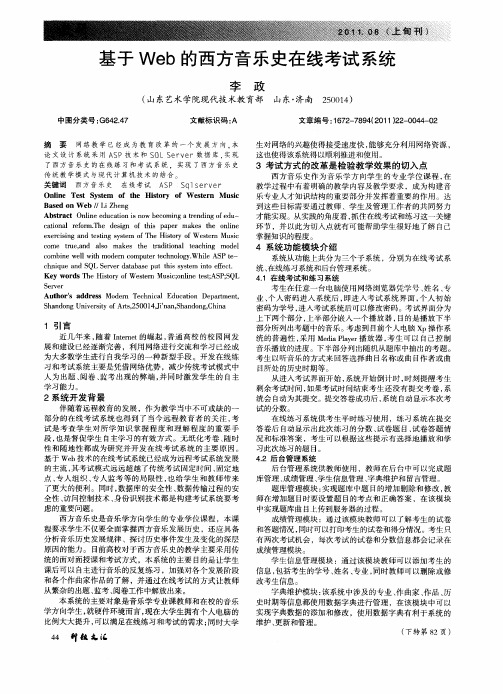
系统从功能上共分 为三个子 系统 ,分别为在线 考试系 统、 在线 练习系统和后 台管理系统。 41 在 线 考试 和 练 习 系统 . 考生在任意一 台电脑使用 网络浏 览器凭学号 、 姓名 、 专 业 、 人 密 码 进 入 系 统 后 , 进 入 考 试 系 统 界 面 , 人 初 始 个 即 个 密码为学号 , 进入考试系统后可以修 改密码 。考试界面分为 上下两个部分 , 上半部分嵌入一个播放器 , 目的是播 放下半 部分所列出考题中的音乐 。 考虑到 目前个人 电脑 x p操作系 统 的普遍 性 , 采用 M da l e 播放器 , e iPa r y 考生可 以 自己控 制 音乐播放的进度。下半部分列 出随机从题库中抽 出的考题 。 考生 以听音乐 的方式来 回答选择 曲 目名称或 曲 目作 者或 曲 目所处 的历史时期等。 从进入考试界面开始 , 系统开始倒计 时 , 时刻提醒考生 剩余考试 时间 , 如果考试时间结束考生还 没有提交考卷 , 系 统会 自动为其提交。提交答卷成功后 , 系统 自动 显示本次考 试 的分 数 。 在线练习系统供考生平 时练习使用 ,练 习系统 在提交 答卷后 自动显示 出此次练 习的分数 、 试卷题 目、 试卷 答题情 况和标准答案 ,考 生可 以根据这 些提示有选择地播 放和学 习此次练习的题 目。 42 后台管理系统 . 后 台管理 系统供教 师使 用 ,教师在后 台中可以完成题 库管理 、 成绩管理 、 学生信 息管理 、 字典维护和 留言管理 。 题库管理模块 : 实现题库 中题 目的增 加删除和修改 , 教 师在增加题 目时要设置题 目的考点和正确答案 ,在该模块 中实现题库 曲目上传到服务器 的过程 。 成绩管理模块 :通过该模块 教师可 以了解 考生的试卷 和答题情况 , 同时可 以打印考生的试卷 和得分情况 。考生只 有两次考试机会 ,每次考试 的试 卷和分数信息都 会记录在 成绩管理模块。
基于Web的在线考试系统
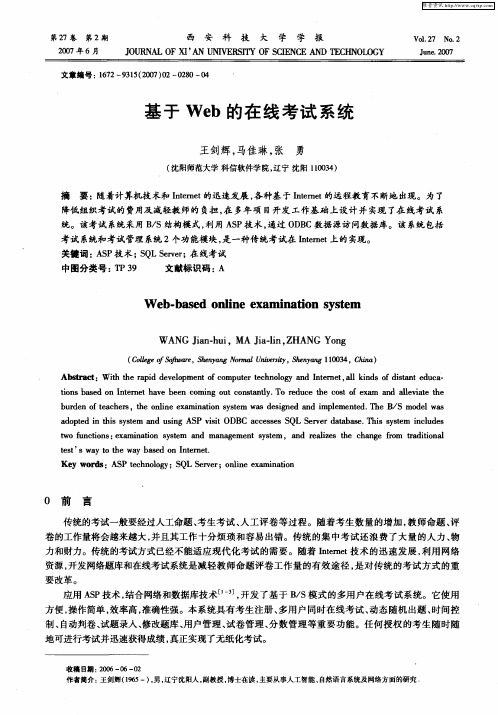
第 2期
王剑辉等 : 于 we 基 b的在线考试 系统
降低组织考试的费用及减轻教师的 负担 , 多年项 目开发工作基础上设计并实现 了在 线考试 系 在
统 。该考试 系统 采用 B S结构模 式 , 用 A P技 术 , 过 O B / 利 S 通 D C数据 源访 问数据库 。该 系统 包括
考试 系统和考试管理 系统 2个功能模块, 是一种传统考试在 It nt n re上的实现。 e 关键词: S A P技术; Q r r 在线考试 S LS v ; ee
维普资
20 0 7年 6月
西
安
科
技
大 学 学 报
V 12 N . 0. 7 o2
J 『NA . F Ⅺ ’ 1 ERS OI R IO AN I v ⅡY C N E AN I 删 O 0G OF S Ⅲ C D EC 1 Y
卷 的工作量将 会越 来越 大 , 且其 工作 十 分烦 琐 和容 易 出错 。传统 的集 中 考试 还 浪 费 了大 量 的人 力 、 并 物
力和财力。传统的考试方式已经不能适应现代化考试的需要。随着 It t ne 技术的迅 速发展 , me 利用网络 资源 , 开发网络题库和在线考试 系统是减轻教师命题评卷工作量的有效途径 , 是对传统的考试方式的重
基于web的在线考试系统任务书

四川理工学院
毕业设计(论文)任务书
如需整套源程序代码请联系:QQ 821213166
设计(论文)题目:基于web的网络考试系统的设计与实现
学院:计算机学院专业:网络工程班级:2008级4班学号:08101030xxx
学生:张xx 指导教师:赵攀
接受任务时间2011年12月15日
系主任(签名)教学院长(签名)1.毕业设计(论文)的主要内容及基本要求
本论文主要从社会现状和生产需求的情况,为简化现代化教育考试模式及流程,实现智能考试,智能阅卷,智能评出学生成绩而设计的基于WEB的考试系统的设计与实现而撰写的论文,文中主要说明基于web考试系统的开发过程,以及如何实现各个功能模块,实现最终的考试系统,从而方便学校、企业以及其他部门使用该系统,实现高效的无纸化考试。
2.指定查阅的主要参考文献及说明
[1] 张钢.ASP网站建设专家[J].机械工业出版社,2001,26.
[2] 宋彦浩.建网技术源代码公开[J].中国水利水电出版社,2001.5
[3] 庄水龙.INSTANT ASP—实例解析ASP网站编程[M].2002.1
[4] 李瑞旭.ASP实例教程[J].中国电力出版社,2000.8
[5] 网冠科技.ASP 3.0时尚编程百例[M].机械工业出版社,2001
[6]梁建武、陈语林,ASP程序设计[M].中国水利水电出版社,2001
[7]石志国.ASP动态网站编程[J].新东方电脑教材研发室, 2001.9
[8] 立雅科技.网页整合大全[M].电子工业出版社,2004
[9] 王志良、薛为民.ASP精解案例教程[M].清华大学出版社,2004。
基于.NET技术在线考试系统论文

基于.NET技术的在线考试系统【摘要】今天,网络技术已逐渐渗入到社会生活的各个层面,传统的考试方式也面临着变革,而网络考试则是一个很重要的方向。
【关键词】考试系统;数据库;;客户端1. 引言目前学校与社会上的各种考试大都采用传统的考试方式。
显然,随着考试类型的不断增加及考试要求的不断提高,教师的工作量将会越来越大,其工作也将变成一件十分繁琐和非常容易出错的事情。
随着计算机应用及网络技术的迅猛发展,人们迫切要求利用这些技术来进行在线考试,以减轻教师的工作负担以及提高工作效率、提高考试的质量。
从而使考试更趋于公证、客观。
因此,我们基于.net技术构建了一个在线考试系统。
2.关键技术2.1系统采用visual 平台,运用技术:结构是一个三层系统:ui层、业务逻辑层和数据层。
2. 2.系统开发采用.net平台下的c#语言:c#是.net平台的通用开发工具,它能够建造所有的.net应用。
其固有的语法简洁,与web的紧密结合,完整的安全性与错误处理等特性,保证了它是一种高效,安全,灵活的现代程序设计语言。
2. 3..采用ms sql server 2000数据库服务器;sql server 数据库能够轻而易举地通过internet的内部网络加以访问。
sql server提供了一系列方法将数据填充到您的web服务器,同时提供了对数据的快捷访问,它是一种可伸缩,高性能的数据库管理系统,具备内置的复制能力,internet集成,开发系统结构以强大的基于gui的管理工具。
它的一个独特功能是基于服务器的作业调度系统,允许直观地控制多个服务器和远程操作。
这极大地增加了数据库的性能和可靠性。
2. 4.web模块:采用b/s结构,即browser/server(浏览器/服务器)结构,是随着internet技术的兴起,对c/s结构的一种变化或者改进的结构。
在这种结构下,用户界面完全通过www浏览器实现,一部分事务逻辑在前端实现,但是主要事务逻辑在服务器端实现,形成所谓3-tier结构。
在线考试系统论文1

摘要网络使用的日益广泛,使得人们对网站的质量的要求越来越高。
人们想要看到的网站已不再是文字和图片的简单组合,而需要网页的具有审美、使用价值的同时网页之间可以更完美的交互,这就给网站设计者带来很大的挑战。
ASP其实是一套微软开发的服务器端脚本环境,它内含于IIS中。
通过ASP,我们可以结合HTML网页、javascript、ASP指令和ActiveX组建建立动态、交互且高效的web服务器应用程序。
有了ASP,就不必担心客户浏览器是否能运行我们所编写的代码,因为所有的代码都将在服务器端运行,包括所有嵌在普通HTML中的脚本程序。
在线考试系统是学生学习过程中的一个辅助工具,基于Internet或者局域网,其主要功能是实现学生在学习过程中通过本系统对课程进行各个章节的综合测试和评分,以检验学习效果。
管理员利用本系统可以进行试卷的测试。
同时系统能过进行分数的统计以及成绩的查询,为学生及教师在学习过程中提供帮助。
在线考试系统旨在实现考试的无纸化管理,对一些科目的考试可以通过互联在线或局域网进行,方便校方考务的管理,也方便了考生,尤其适在线考试系统旨在实现考试的无纸化管理,对一些科目的考试可以通过互联在线或局域网进行,方便校方考务的管理,也方便了考生。
关键字:在线考试系统、asp、sql serverABSTRACTThe network increasingly widely used, making it the quality of the site have become increasingly demanding. People want to see the site is no longer a simple combination of words and pictures, and aesthetic needs of the page, between the value of the same web page could be more perfect interaction, which gives web designers a great deal of challenge .ASP is a Microsoft development environment for server-side script, which includes the IIS. Through the ASP, we can combine HTML pages, ASP and ActiveX command set up to create dynamic, interactive and efficient web server applications.With ASP, you do not worry about whether the client browser to run the code we write, because all of the code will run in the server, including all embedded in ordinary HTML in scripts.Online examination system is a learning process support tool, based on the Internet or local area network, its main function is to achieve the students in the learning process through the system in all sections of the curriculum for the comprehensive test, to test learning. The system administrator can use the test papers.At the same time the system can be made for a fraction of the statistics and the results of the inquiry, for students and teachers to assist in the learning process. Online examination system to achieve paperless management of examinations, the examination for some courses online through the Internet or LAN, to facilitate the management of the school Examination, candidates are also convenient, especially suitable for online examination system designed to achieve the non-test paper management, the examination of some subjects can be online or LAN through the Internet to facilitate the management of the school Examination, candidates are also convenient.Keywords: online examination system, asp,sql server目录摘要 (1)ABSTRACT (2)第一章前言 (1)第一节Asp简介 (1)第二节数据库简介 (1)第三节系统开发意义 (2)第二章选题及本次课程设计的任务.错误!未定义书签。
文献译文-新型的基于web的在线考试系统

A NOVEL WEB-BASED ONLINE EXAMINATIONSYSTEM FORCOMPUTER SCIENCE EDUCATIONYuan Zhenming1, Zhang Liang2, Zhan Guohua3AbstractWeb-based Examination System is an effective solution for mass education evaluation. We have developed a novel online examination system based on a Browser/Server framework which carries out the examination and auto-grading for objective questions and operating questions, such as programming, operating Microsoft Windows, editing Microsoft Word, Excel and PowerPoint, etc. It has been successfully applied to the distance evaluation of basic operating skills of computer science, such as the course of computer skills in Universities and the nationwide examination for the high school graduates in Zhejiang Province, China.1. WEB-BASED ONLINE EXAMINATION SYSTEM1.1The aim of the examination systemAs a universal examination system for the education of basic computer operation, it must meet the following requirements:1. A reasonable question storage, which must conform to the general outline of the exam.2. A practical interface. There are two types of exam interfaces. One is the simulation, the other is the actual environment. The second scheme will give the student computer skills.3. A range of question types, such as objective questions, operating questions, design questions, information retrieval, group testing, etc.4. A safety and reliable examination system.1.2 The components of WOESThe Web based Online Examination System (WOES) is a multi-layer system which is composed of the Web Server, Database Server, and WOES middleware Server, WOES client module and Browser, such as Internet Explorer. In this system, we use the Internet Information Server 4.0(IIS) as the Web Server, the Database Server is Microsoft SQL Server 7.0.The kernel of WOES is the WOES middleware Serve and the WOES client module, which is designed according to Microsoft DCOM standards. DCOM is the binary COM object’s extension jointing LAN, WAN and Internet, which can instance and bind objects over different network. It is an advanced network protocol used to cooperate with COM based components of two processes in different locations. The WOES middleware Server is a server-side component The WOES middleware Server is a server-side component providing communication interfaces between WOES clients and the Web Server or Database Server. The WOES client is a client-side component, which is called by the Browser to control the client computer and submit or receive information from the WOES Server. This technology guarantees the flexibility and the potential for extension of the test system. In addition, it allows access to local files, whereas in conventional systems, the IE security prevents such access.1.3 The key technologies of WOES1. A user-friendly interfaceWe use br owser as our user’s interface. The Browser interface has a uniform and consistent user interface. Almost everyone is able to use it skillfully. Therefore it can eliminate the differences of various exam systems and guarantee a fair test.2. Simplified system maintenanceSince the system is based on Browser/Server architecture, the teacher can update the system or the question database o examine the student’s database only in Server. It is not necessary to update the client system as the Client/Server must do.3. Central examination managementProfiting from the central controlled system, the teacher can easily control the examination process, such as the beginning and end of the exam, collecting the answers and monitoring the students’ conditions on the te acher’s screen.4. SecurityThe most severe difficulty which the B/S based system faces is security, because in principle the web-based examination system can be accessed on the Internet or WAN in a city.All the questions, materials and answers are transmitted in bits stream format after encoding, not in file format. It can ensure not only security in the transmission process, but also protect from invasion.When one student starts his test, the system will distribute him a password produced according to his client’s hardware and operation system environment. It can prevent cribbers to login from other clients imitating this student.The newest method to prevent the distant student from leaving the client or is making use of face detection and recognition technology. Before the start of the exam, the student is asked to sit in front of thecomputer camera, which can monitor the whole scene. Then the system will automatically recognize the student’s face and his identification. As soon as the validation is performed, the student must stay in front of the camera until the exam is finished.2. AUTO-GRADING SYSTEMThe auto-grading system can automatically grade the answers, which are collected from the examination system. It helps teachers to achieve the score with ease.There are two types of the grading: objective questions and operating questions. Objective questions, such as choice questions, yes/no questions, and fill-in questions, can be graded effectively by accurate matching or fuzzy matching. But it is difficult to grade operating questions by simple matching technologies.A possible solution could be: Reading the answer file directly and comparing it to the key file. But this is not practical because the format of Microsoft Office files is complicated.Another solution is: (2) grading by using the Office OLE object. This method is convenient and efficient, but it has a big disadvantage: the source code of the grading system is closely related to the concrete question, which results in a large amount of work when the questions are changed.We propose a universalized grading system, which is carried out on the basis of a database of key knowledge.First, we extract all possible knowledge points and store them in a triple form: (key, value, location). Then we produce the question file by labeling the question point directly on it; the system will add the corresponding question key to the standard key library. So, the last process of auto-grading system is to compare the answer file with the standard key library. The auto-grading system also allows the teacher to add his /her own questions to our examination system.3. CONCLUSIONWe have developed an overall solution to the examination system for practical computer skills. It provides a user- friendly platform of various questions for the basic computer education in Universities. Hundreds of thousands of students and teachers have used this system and agree that it has effectively raised the learning and testing efficiency.一种新型的基于web的在线考试系统Yuan Zhenming1, Zhang Liang2, Zhan Guohua3摘要基于web的在线考试系统是大众教育评估的一种有效解决方法。
基于web技术的网络实时考试系统开发
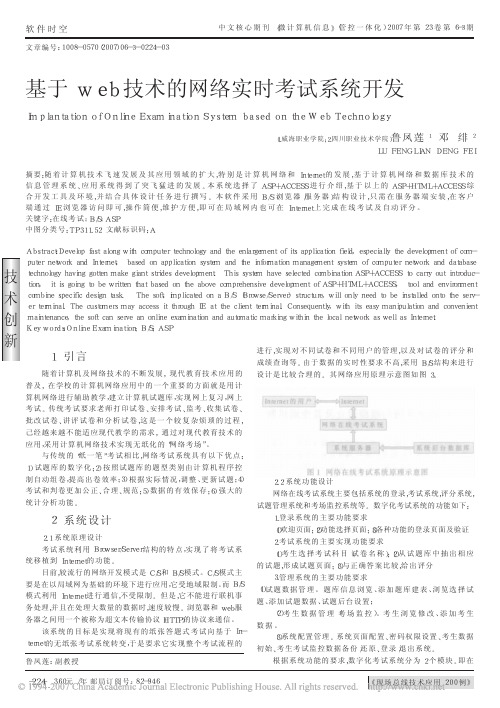
技术创新中文核心期刊《微计算机信息》(管控一体化)2007年第23卷第6-3期360元/年邮局订阅号:82-946《现场总线技术应用200例》软件时空1引言随着计算机及网络技术的不断发展,现代教育技术应用的普及,在学校的计算机网络应用中的一个重要的方面就是用计算机网络进行辅助教学,建立计算机试题库,实现网上复习,网上考试。
传统考试要求老师打印试卷、安排考试、监考、收集试卷、批改试卷、讲评试卷和分析试卷,这是一个较复杂烦琐的过程,己经越来越不能适应现代教学的需求,通过对现代教育技术的应用,采用计算机网络技术实现无纸化的“网络考场”。
与传统的“纸一笔”考试相比,网络考试系统具有以下优点:1)试题库的数字化;2)按照试题库的题型类别由计算机程序控制自动组卷,提高出卷效率;3)根据实际情况,调整、更新试题;4)考试和判卷更加公正、合理、规范;5)数据的有效保存;6)强大的统计分析功能。
2系统设计2.1系统原理设计考试系统利用Browser/Server结构的特点,实现了将考试系统移植到Internet的功能。
目前,较流行的网络开发模式是C/S和B/S模式。
C/S模式主要是在以局域网为基础的环境下进行应用,它受地域限制。
而B/S模式利用Internet进行通信,不受限制。
但是,它不能进行联机事务处理,并且在处理大数量的数据时,速度较慢。
浏览器和web服务器之间用一个被称为超文本传输协议(HTTP)的协议来通信。
该系统的目标是实现将现有的纸张答题式考试向基于In-ternet的无纸张考试系统转变,于是要求它实现整个考试流程的进行,实现对不同试卷和不同用户的管理,以及对试卷的评分和成绩查询等。
由于数据的实时性要求不高,采用B/S结构来进行设计是比较合理的。
其网络应用原理示意图如图3。
图1网络在线考试系统原理示意图2.2系统功能设计网络在线考试系统主要包括系统的登录,考试系统,评分系统,试题管理系统和考场监控系统等。
基于WEB的在线考试系统的设计与实现

图4 :考试界面
7 8 ・ 电子 技术 与软件 工 程
E l e c t r o n i c T e c h n o l o g y &S o f t w a r e E n g i n e e r i n g
别用 来检 测人 体 红外 线,汽 车加
速度 ,汽车震动 。G S M通信采用 了 M D 2 3 1 模 块,可以 实现短信收发 、
随着 通信技 术的发展 , 无线远程 通信技 术也 被应用于汽车领域中。 本设计 采用基于 G S M 短消息数 据传输技 术 的汽车 防盗 系统 ,不仅可 以提高报警的通信 可靠程度 ,而且通信距离基本不受 限制 ,从而 实现用户对汽车 的长距离监控 。便于车主根据 情况采取措施 , 满足了车主对 汽车 防盗 的要求 。 另外,系统依托覆 盖率极高 的 G S M 网络 ,利 用G S M 无线通信业务 和短消息增值 业务 ,具 有实现简单、通信成本低 、频谱利用率高和保
软件开发 ・ S o f t w a r e D e v e l o p me n t
基于手机通信的汽车防盗系统 的研 究
文/ 朱新宇 苗 志 全
1引言
本 设 计 的 汽 车 防 盗 系统 , 结 合 了传 统 防 盗 技 术 和 新 型 的 G P R S 无 线通信 技 术,以 S T C 1 2 C 5 A 6 0 S 2
地 实现了通信 报警 ,而且突破 了距离 的限制 , 具有技术 含量 高、智 能化 、网络化 的特点 。该
随着 人们 生活 水平 的提高 ,汽车 已逐 步
进入 家庭 , 但 日益猖獗 的汽车盗 窃案件 也呈
系统安装 简单 、 功能强 、 便于应用、 易于推广 。
基于Web考试系统的设计与实现

基于Web考试系统的设计与实现【摘要】通过网上在线考试系统,考生几乎可以在任何地方参加考试,在很大程度上拓展了考试的灵活性。
在交卷不到一秒钟的时间内便可知道自己的考试成绩。
本系统采用asp+access数据库结合设计的一个在线考试系统实现了此用途。
【关键词】在线考试 asp 试卷管理 access数据库1、绪论基于web技术的网络考试系统可以借助于遍布全球的因特网进行,因此考试既可以在本地进行,也可以在异地进行,大大拓展了考试的灵活性。
试卷可以根据题库中的内容按条件组成,可避免考试前的压题;还可以直接把成绩送到数据库中,进行统计分析、排序等操作。
现在较好的考试方法是采用网络考试,考生通过姓名、准考证号码和口令进行登录,登录后进行考试,考试答案也存放在服务器中,这样考试的公平性、答案的安全性可以得到有效的保证。
网络考试系统的实现技术有多种,本文讨论的网络考试系统采用web 技术实现。
web技术采用了三层体系结构:用户界面层/事务层/数据库层,因此web结构有着更好的安全性。
本考试系统是由asp+access数据库开发的。
主要具有如下功能:通过后台管理程序可以动态添加,删除,和修改题库中的题目;从题库中随机选题组成试卷;考生注册和登陆;当有考生登陆时,随机分配一套试卷给考生;当考生答题完毕交卷后,自动给出得分,正误信息或者解答。
2、开发软件和开发环境本次开发程序所使用的开发工具是microsoft公司的asp,数据库管理软件采用的是microsoft公司的access 2000。
可以用asp 来创建动态web页或生成功能强大的web应用程序。
使用asp可以组合html页,脚本命令和active x 组件来创建动态交互的web页和基于web 的应用程序。
asp没有固定的开发工具,任何一种文本编译器都可以胜任asp脚本的编辑工作,当然不同的开发工具开发调试的效率不一样的。
使用普通的文本编辑器,如windows的记事本,即可进行编辑设计。
在线考试系统文献综述

《科技文献检索》课程“文献综述”评分表学生姓名完成时间2017 年 1 月指导老师文献综述题目在线考试系统姓名学号系部理工系年级专业指导教师2017年 1 月 06 日在线考试系统文献综述【摘要】通过软件进行考试的方式被称为无纸化考试,随着无纸化考试的诞生,原始的考试方式已经渐渐地被无纸化考试所取代。
在线考试系统是基于C#编程技术把学科、试题、电脑改卷、结果查询的部分管理工作集成到一个同一的平台,各管理人员能够及时、准确的了解学生学习生活情况。
同时,也可以方便老师针对学生的不同情况进行分层次帮助引导。
考试是对学生所学知识检查、掌握和理解知识程度的重要手段,无纸化的考卷,无纸化考试的随时性,随地性,这些特点都是研究并开发网络考试系统具有重要积极的意义,将给学生和老师带来了极大的便利。
无纸化考试,环保、节约资源,适应当代社会发展的发展。
本文重点论述了由于网络的存在扩大了学校的服务范围,为学校的管理提供了更多的条件。
对此做出了详细的调查,可行性研究和分析。
系统采用了B/S结构,在网络上建立学校自己的教育网站。
系统开发经历了系统分析、系统设计和系统实施三个阶段。
从设计方案的提出,经过详细的调查,分析了方案的可行性和必要性,通过详细的系统设计,力图提高系统的集成性和快捷性;并在系统实施阶段收集了大量的实验数据,以便测试阶段系统的准确性和稳定性。
关键词:管理员维护系统,考生考试系统,B/S模式,ASP技术【前言】考试是教学过程中的一个重要环节,通过考试,教师可以了解学生的学习效果,为改进教学提供依据;学生则通过考试了解自己对内容的掌握情况,增强学习兴趣。
传统的考试方式往往使人们受到地域、时间、场所等各种各样的限制,造成有些人的不便。
在网络遍布的今天,将考试系统应用在互联网上是现代考试系统的发展趋势。
随着计算机技术和互联网的快速发展,人类已经进入了信息时代,也有人称为数字化时代。
在数字化的网络环境下,学生希望得到个性化的满足,根据自己的情况进行学习,同时也希望能够得到科学的评价,老师希望有效改进现有的考试模式,提高考试的效率;教育机构也希望给网上的学生提供更全面、灵活的服务,全面准确地对学生进行跟踪和评论。
基于Web技术的通用网络考试系统
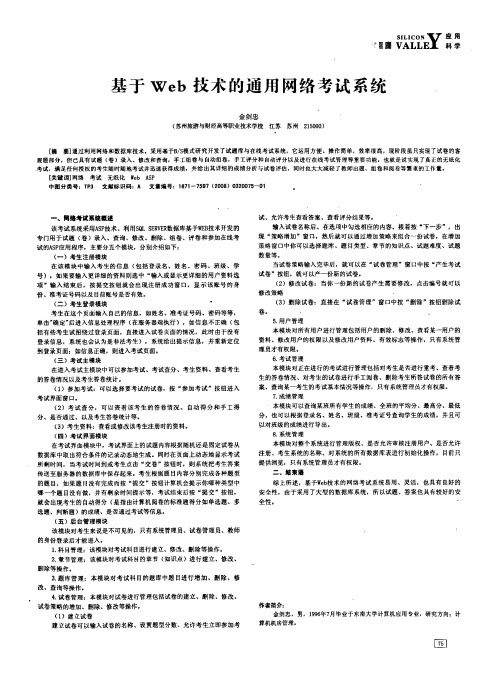
中图分类号: TP3 文献标识码: A 文派编号: 1671一7597 ( 2008) 0320075一01
一、网络考试系统概述 该考试系统采用A 技术、利用SQ SER ER P S L V 数据库基于呢B技术开发的 专门用于试题 ( 卷) 录入、查询、修改、删除、组卷、评卷和参加在线考 试的A P应用程序,主要分五个模块,分别介绍如下: s ( 一) 考生注册模块 在该模块中输入考生的信息 ( 包括登录名、姓名、密码、班级、学 号) ,如果要输入更详细的资料则选中 “ 输入或显示更详细的用户资料选 项”输入结束后,按提交按钮就会出现注册成功窗口,显示该账号的身 份、准考证号码以及目前账号是否有效. ( 二) 考生登录模块 考生在这个页面输入自己的信息,如姓名、准考证号码、密码等等, 单击产 确定’ 后进入信息处理程序 ( 在服务器端执行) ,如信息不正确 ( 包 括有些考生试图绕过登录页面,直接进入试卷页面的情况,此时由于没有 登录信息,系统也会认为是非法考生) ,系统给出提示信息,并重新定位 到登录页面; 如信息正确,则进入考试页面。 ( 三) 考试主模块 在进入考试主模块中可以参加考试、考试查分、考生资料、查看考生 的答卷情况以及考生答卷统计。 ( 1 参加考试: 可以选择要考试的试卷,按 “ ) 参加考试”按钮进入 考试界面窗口. ( 2) 考试查分,可以查看该考生的答卷情况、自动得分和手工得 分、是否通过、以及考生答卷统计等。 ( 3) 考生资料: 查看或修改该考生注册时的资料。 ( 四) 考试界面模块 在考试界面模块中,考试界面上的试题内容根据随机还是固定试卷从 数据库中取出符合条件的记录动态地生成。同时在页面上动态地显示考试 所剩时间,当考试时间到或考生点击 “ 交卷即按钮时,则系统把考生答案
【文献综述】VB题库管理系统

文献终述报告主要概念及相关知识叙述试题库系统是目前迅速发展起来的新型计算机辅助教学的一种有利的工具,是计算机科学、教育测量理论科学相结合的产物,是计算机辅助教学系统的一个新的实用的发展方向。
题库是按照一定的教育测量理论,在计算机系统中实现的某个学科题目的集合,是严格遵循教育测量理论,在精确的数学模型基础上建立起来的教育测量工具。
试题库的种类和品种十分繁多。
最常用、最传统的试题库是各种习题集及其解答、分析类的图书,一般用于学生的平时训练。
其次比较常用的是以套题形式出现的试题库,这类题库往往掌握在教师手中,一般用于阶段性测试或各种考试。
目前最流行的是基于计算机的电子试题库,这种试题库便于海量试题的存储、使用和修改,更便于试题和试卷的难度划分、采分点的运用和试后分析等。
试题库的出现和发展显示出强大的生命力,在教学活动中发挥了重要作用,不仅弥补了传统教学的部分缺陷,而且将计算机在教学管理中的应用推向了一个新的阶段,引起了计算机界和教育界广泛的兴趣和重视。
目前,在国外,试题库系统己开始应用于各个教学阶段,特别是大、中学的考试和作业以及正迅猛发展的远程教育等方面的应用,收到了显著的效果。
我国试题库系统的研究和应用最广泛的领域是考试和组卷方面。
我国不少院校和公司在智能化试题库系统的研制中也取得了显著成绩。
教学过程中充分利用题库这种教学资源,进行有效的测验,可以帮助师生把注意力从名次、得分集中到要实现的教学目标上来。
让教师真正关心学生的学习困难和错误所在,关心学生素质的提高,促使教育观念从“应试教育”向“素质教育”转变。
因此,对题库进行研究和建设是有十分重要的意义,也是非常有实用价值的。
试题库在教学实践中有独特的优势:一是教学管理上的,即题库具有高效、经济、灵活和保密的特点;二是教学测量上的,即由题库生成的试卷具有质量高、可预控等特点。
这是试题库产生的理论意义。
主要开发工具本系统主要用Visual Basic 6.0 作为主要开发工具,用Microsoft Access 2003作为后台数据库。
- 1、下载文档前请自行甄别文档内容的完整性,平台不提供额外的编辑、内容补充、找答案等附加服务。
- 2、"仅部分预览"的文档,不可在线预览部分如存在完整性等问题,可反馈申请退款(可完整预览的文档不适用该条件!)。
- 3、如文档侵犯您的权益,请联系客服反馈,我们会尽快为您处理(人工客服工作时间:9:00-18:30)。
A NOVEL WEB-BASED ONLINE EXAMINATIONSYSTEM FORCOMPUTER SCIENCE EDUCATIONYuan Zhenming1, Zhang Liang2, Zhan Guohua3AbstractWeb-based Examination System is an effective solution for mass education evaluation. We have developed a novel online examination system based on a Browser/Server framework which carries out the examination and auto-grading for objective questions and operating questions, such as programming, operating Microsoft Windows, editing Microsoft Word, Excel and PowerPoint, etc. It has been successfully applied to the distance evaluation of basic operating skills of computer science, such as the course of computer skills in Universities and the nationwide examination for the high school graduates in Zhejiang Province, China.1. WEB-BASED ONLINE EXAMINATION SYSTEM1.1The aim of the examination systemAs a universal examination system for the education of basic computer operation, it must meet the following requirements:1. A reasonable question storage, which must conform to the general outline of the exam.2. A practical interface. There are two types of exam interfaces. One is the simulation, the other is the actual environment. The second scheme will give the student computer skills.3. A range of question types, such as objective questions, operating questions, design questions, information retrieval, group testing, etc.4. A safety and reliable examination system.1.2 The components of WOESThe Web based Online Examination System (WOES) is a multi-layer system which is composed of the Web Server, Database Server, and WOES middleware Server, WOES client module and Browser, such as Internet Explorer. In this system, we use the Internet Information Server 4.0(IIS) as the Web Server, the Database Server is Microsoft SQL Server 7.0.The kernel of WOES is the WOES middleware Serve and the WOES client module, which is designed according to Microsoft DCOM standards. DCOM is the binary COM object’s extension jointing LAN, WAN and Internet, which can instance and bind objects over different network. It is an advanced network protocol used to cooperate with COM based components of two processes in different locations. The WOES middleware Server is a server-side component The WOES middleware Server is a server-side component providing communication interfaces between WOES clients and the Web Server or Database Server. The WOES client is a client-side component, which is called by the Browser to control the client computer and submit or receive information from the WOES Server. This technology guarantees the flexibility and the potential for extension of the test system. In addition, it allows access to local files, whereas in conventional systems, the IE security prevents such access.1.3 The key technologies of WOES1. A user-friendly interfaceWe use br owser as our user’s interface. The Browser interface has a uniform and consistent user interface. Almost everyone is able to use it skillfully. Therefore it can eliminate the differences of various exam systems and guarantee a fair test.2. Simplified system maintenanceSince the system is based on Browser/Server architecture, the teacher can update the system or the question database o examine the student’s database only in Server. It is not necessary to update the client system as the Client/Server must do.3. Central examination managementProfiting from the central controlled system, the teacher can easily control the examination process, such as the beginning and end of the exam, collecting the answers and monitoring the students’ conditions on the te acher’s screen.4. SecurityThe most severe difficulty which the B/S based system faces is security, because in principle the web-based examination system can be accessed on the Internet or WAN in a city.All the questions, materials and answers are transmitted in bits stream format after encoding, not in file format. It can ensure not only security in the transmission process, but also protect from invasion.When one student starts his test, the system will distribute him a password produced according to his client’s hardware and operation system environment. It can prevent cribbers to login from other clients imitating this student.The newest method to prevent the distant student from leaving the client or is making use of face detection and recognition technology. Before the start of the exam, the student is asked to sit in front of thecomputer camera, which can monitor the whole scene. Then the system will automatically recognize the student’s face and his identification. As soon as the validation is performed, the student must stay in front of the camera until the exam is finished.2. AUTO-GRADING SYSTEMThe auto-grading system can automatically grade the answers, which are collected from the examination system. It helps teachers to achieve the score with ease.There are two types of the grading: objective questions and operating questions. Objective questions, such as choice questions, yes/no questions, and fill-in questions, can be graded effectively by accurate matching or fuzzy matching. But it is difficult to grade operating questions by simple matching technologies.A possible solution could be: Reading the answer file directly and comparing it to the key file. But this is not practical because the format of Microsoft Office files is complicated.Another solution is: (2) grading by using the Office OLE object. This method is convenient and efficient, but it has a big disadvantage: the source code of the grading system is closely related to the concrete question, which results in a large amount of work when the questions are changed.We propose a universalized grading system, which is carried out on the basis of a database of key knowledge.First, we extract all possible knowledge points and store them in a triple form: (key, value, location). Then we produce the question file by labeling the question point directly on it; the system will add the corresponding question key to the standard key library. So, the last process of auto-grading system is to compare the answer file with the standard key library. The auto-grading system also allows the teacher to add his /her own questions to our examination system.3. CONCLUSIONWe have developed an overall solution to the examination system for practical computer skills. It provides a user- friendly platform of various questions for the basic computer education in Universities. Hundreds of thousands of students and teachers have used this system and agree that it has effectively raised the learning and testing efficiency.一种新型的基于web的在线考试系统Yuan Zhenming1, Zhang Liang2, Zhan Guohua3摘要基于web的在线考试系统是大众教育评估的一种有效解决方法。
